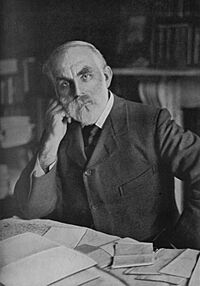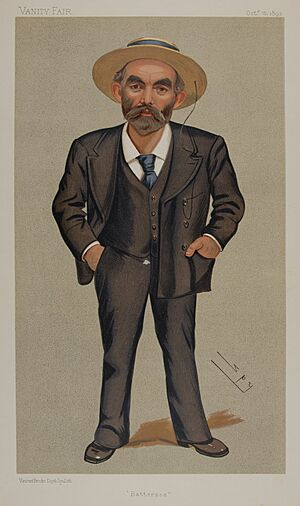John Burns facts for kids
Quick facts for kids
John Burns
|
|
|---|---|

Burns, circa 1911
|
|
| President of the Local Government Board | |
| In office 10 December 1905 – 11 February 1914 |
|
| Monarch | Edward VII George V |
| Prime Minister | Sir Henry Campbell-Bannerman H. H. Asquith |
| Preceded by | Gerald Balfour |
| Succeeded by | Herbert Samuel |
| President of the Board of Trade | |
| In office 11 February 1914 – 5 August 1914 |
|
| Monarch | George V |
| Prime Minister | H. H. Asquith |
| Preceded by | Sydney Buxton |
| Succeeded by | Walter Runciman |
| Personal details | |
| Born | 20 October 1858 Vauxhall, London, England |
| Died | 24 January 1943 (aged 84) |
| Citizenship | United Kingdom |
John Elliot Burns (born October 20, 1858 – died January 24, 1943) was an important English trade unionist and politician. He was especially known for his work in London, particularly in the area of Battersea. John Burns started as a socialist and later became a member of the Liberal Party. He served as a Member of Parliament (MP) and a government minister. He was also a strong supporter of the anti-alcohol movement and loved sports. When the government decided to go to war in 1914, he resigned. After leaving politics, he became an expert in London history. He famously said, "The Thames is liquid history."
Contents
Early Life and Education
John Burns was born in London in 1858. His father, Alexander Burns, was a fitter from Scotland. John grew up in Battersea. He went to a local school until he was ten years old.
After school, he worked various jobs. At 14, he started a seven-year apprenticeship to become an engineer. He also continued his education by attending night-schools. He read many books, especially about ideas for a better society.
In 1879, he joined the Amalgamated Society of Engineers, a trade union. He also helped start a local branch of the Social Democratic Federation (SDF) in Battersea in 1881. He even worked on a ship and spent a year in West Africa as an engineer.
Becoming a Political Activist
John Burns became very active in politics. In 1884, he joined the executive council of the Social Democratic Federation. He spoke out about important issues, which made people notice him.
In 1885, he tried to become a Member of Parliament but was not successful. A year later, he took part in a protest in London about unemployment. This protest led to some damage in the city. He was arrested but later found not guilty.
In 1887, he was arrested again during a large protest in Trafalgar Square. This event became known as 'Bloody Sunday'. John Burns was sent to prison for six weeks.
Leading the Dock Strike
In August 1889, John Burns played a huge role in the London Dock Strike. He was one of the best speakers for the workers. Every day, he led the striking workers on a march through London. He was famous for wearing his straw hat.
He worked with other leaders like Tom Mann and Ben Tillett. Together, they helped the dockworkers win their demands. At this time, he was still working as an engineer and was active in his trade union.
Local Government Work
In 1889, John Burns was elected to the first London County Council. He represented Battersea. His local supporters gave him a small allowance to help him do his work.
He worked hard to fight against private companies that had too much control. In 1892, he helped pass a rule that all council work should pay fair trade union wages. He is also remembered for helping create the Latchmere Estate in Battersea. This was the first municipal housing estate built by the council itself, and it opened in 1903.
National Politics and Minister Role

In 1892, John Burns was elected as the Member of Parliament for Battersea. He was known for being an independent thinker. He strongly opposed the Second Boer War in 1900.
Even though he started as a socialist, he stayed with the Liberal Party. In 1905, he became the President of the Local Government Board. This made him one of the first working-class men to become a government minister. He was proud of his background, once saying, "I am not ashamed to say that I am the son of a washerwoman."
He was praised for his work in government. He supported the idea of old-age pensions, which helped older people financially. In 1914, he was made President of the Board of Trade. However, on August 2, 1914, just before Britain entered the First World War, he resigned from the government as a protest against the war. He did not take part in the war and left Parliament in 1918.
Interests and Legacy
John Burns was a non-drinker and loved sports. He was a big fan of cricket and often watched matches. In 1894, he was even hit in the face by a cricket ball while watching a game!
After leaving politics, he became financially independent. He spent the rest of his life enjoying his interests. He collected a very large library of books, many of which he later gave to the University of London Library. He also became an expert in the history of London.
He famously said about the River Thames, "The St Lawrence is water, the Mississippi is muddy water, but the Thames is liquid history." This quote shows his deep love for London's past.
John Burns died at 84 and was buried in St Mary's Cemetery in Battersea. His connection to Battersea is remembered by a local school and a housing estate named after him. A street in Barking and one of the Woolwich Ferry boats also carry his name.


